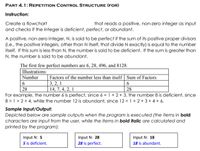
Database System Concepts
7th Edition
ISBN: 9780078022159
Author: Abraham Silberschatz Professor, Henry F. Korth, S. Sudarshan
Publisher: McGraw-Hill Education
expand_more
expand_more
format_list_bulleted
Question
Create a flowchart only

Transcribed Image Text:PART 4.1: REPETITION CONTROL STRUCTURE (FOR)
Instruction:
Create a flowchart
that reads a positive, non-zero integer as input
and checks if the integer is deficient, perfect, or abundant.
A positive, non-zero integer, N, is said to be perfect if the sum of its positive proper divisors
(i.e., the positive integers, other than N itself, that divide N exactly) is equal to the number
itself. If this sum is less than N, the number is said to be deficient. If the sum is greater than
N, the number is said to be abundant.
The first few perfect numbers are 6, 28, 496, and 8128.
|Illustrations:
Number
Factors of the number less than itself Sum of Factors
3, 2, 1
14, 7, 4, 2, 1
6
28
28
For example, the number 6 is perfect, since 6 = 1 + 2 + 3, the number 8 is deficient, since
8 > 1 +2+ 4, while the number 12 is abundant, since 12< 1 + 2 +3+ 4 + 6.
Sample Input/Output:
Depicted below are sample outputs when the program is executed (the items in bold
characters are input from the user, while the items in bold italic are calculated and
printed by the program):
Input N: 5
Input N: 28
Input N: 18
5 is deficient.
28 is perfect.
18 is abundant.
Expert Solution
This question has been solved!
Explore an expertly crafted, step-by-step solution for a thorough understanding of key concepts.
Step by stepSolved in 2 steps with 1 images

Knowledge Booster
Learn more about
Need a deep-dive on the concept behind this application? Look no further. Learn more about this topic, computer-science and related others by exploring similar questions and additional content below.Similar questions
- Trace the following flowchart and complete the Table l (fill in ALL the blanks). Start 13 is Dinplay Display DO NOT leave the blank spoce. If the value of the varioble is not changed, fill the blank with the same value. Table 1 n<15 in/2 Outputarrow_forwardPython Help Write a program that asks the user to enter two numbers. The program is supposed to add the two numbers and display their sum and repeat for different pair of numbers. After each repetition, the program should ask the user if he or she wishes to perform the operation again. If yes repeat, or terminate otherwise. Show the analysis, specifications and flowcharts of the two problems Use documentation by commenting your code Write your code in the script modearrow_forwardCreate a flowchart to show how the following loops will work. 1. Display all numbers from 25 to 225, inclusively (25, 26, ..., 225). 2. Calculate the average for grades. The number of grades is not known, so grades will be entered until -1 is received signaling all grades have been entered. 3. Password Checker - Take in a password and compare to stored password. If the password is correct, allow access to the system, otherwise ask to reenter password. If the wrong password is entered 3 times lockout the system.arrow_forward
arrow_back_ios
arrow_forward_ios
Recommended textbooks for you
 Database System ConceptsComputer ScienceISBN:9780078022159Author:Abraham Silberschatz Professor, Henry F. Korth, S. SudarshanPublisher:McGraw-Hill Education
Database System ConceptsComputer ScienceISBN:9780078022159Author:Abraham Silberschatz Professor, Henry F. Korth, S. SudarshanPublisher:McGraw-Hill Education Starting Out with Python (4th Edition)Computer ScienceISBN:9780134444321Author:Tony GaddisPublisher:PEARSON
Starting Out with Python (4th Edition)Computer ScienceISBN:9780134444321Author:Tony GaddisPublisher:PEARSON Digital Fundamentals (11th Edition)Computer ScienceISBN:9780132737968Author:Thomas L. FloydPublisher:PEARSON
Digital Fundamentals (11th Edition)Computer ScienceISBN:9780132737968Author:Thomas L. FloydPublisher:PEARSON C How to Program (8th Edition)Computer ScienceISBN:9780133976892Author:Paul J. Deitel, Harvey DeitelPublisher:PEARSON
C How to Program (8th Edition)Computer ScienceISBN:9780133976892Author:Paul J. Deitel, Harvey DeitelPublisher:PEARSON Database Systems: Design, Implementation, & Manag...Computer ScienceISBN:9781337627900Author:Carlos Coronel, Steven MorrisPublisher:Cengage Learning
Database Systems: Design, Implementation, & Manag...Computer ScienceISBN:9781337627900Author:Carlos Coronel, Steven MorrisPublisher:Cengage Learning Programmable Logic ControllersComputer ScienceISBN:9780073373843Author:Frank D. PetruzellaPublisher:McGraw-Hill Education
Programmable Logic ControllersComputer ScienceISBN:9780073373843Author:Frank D. PetruzellaPublisher:McGraw-Hill Education

Database System Concepts
Computer Science
ISBN:9780078022159
Author:Abraham Silberschatz Professor, Henry F. Korth, S. Sudarshan
Publisher:McGraw-Hill Education

Starting Out with Python (4th Edition)
Computer Science
ISBN:9780134444321
Author:Tony Gaddis
Publisher:PEARSON

Digital Fundamentals (11th Edition)
Computer Science
ISBN:9780132737968
Author:Thomas L. Floyd
Publisher:PEARSON

C How to Program (8th Edition)
Computer Science
ISBN:9780133976892
Author:Paul J. Deitel, Harvey Deitel
Publisher:PEARSON

Database Systems: Design, Implementation, & Manag...
Computer Science
ISBN:9781337627900
Author:Carlos Coronel, Steven Morris
Publisher:Cengage Learning

Programmable Logic Controllers
Computer Science
ISBN:9780073373843
Author:Frank D. Petruzella
Publisher:McGraw-Hill Education